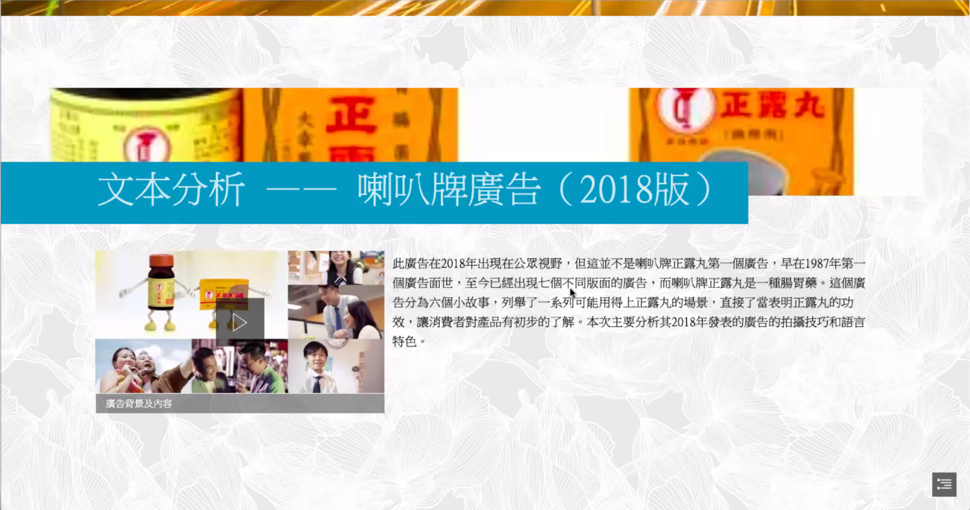Taking Advantage of ePortfolios to Enhance Students’ Reflective Learning:
Sharing by Dr. Sophia Lam
The ePortfolio is an assessment tool that allows course instructors and students to engage in creative expression. It also allows instructors to track students’ development and progress throughout the course. Dr. Sophia Lam, an Assistant Professor from the Department of Chinese Language Studies, used the ePortfolio to assess students in her Cantonese and Hong Kong Local Culture course, which is an elective for students in the Bachelor of Arts in Language Studies programme. Aside from knowledge of Cantonese and Hong Kong culture, the course aims to develop two Generic Intended Learning Outcomes (GILOs): problem-solving and critical thinking skills. After reviewing students’ ePortfolios and performance in Semester 1, 2020/21, Dr. Lam made observations on unique features of the ePortfolio that can enhance students’ reflective learning. She also shared some challenges of using the ePortfolio for assessment.
The ePortfolio allows the instructors to track students’ progress and compare their work in different stages. As a prerequisite, it is important to redesign the course content to coordinate with ePortfolio and course learning outcomes. Dr. Lam reported that the two GILOs (problem-solving and critical thinking skills) were particularly emphasised in the course, and she designed a three-phase learning journey: enhancing knowledge, applying knowledge and developing generic skills. In her course, Dr. Lam introduced common cinematographic techniques used in advertisements to enhance students’ knowledge. Next, she showed some examples and analysed them with the students to see how the examples used techniques relevant to the theme, which allowed students to practise applying their knowledge. Afterward, Dr. Lam posed questions for students to think about and discuss to develop students’ problem-solving and critical thinking skills.
After restructuring the course materials, instructors need to consider the pedagogical approach used in their lectures and prepare guidance for the students to follow. To facilitate the development of GILOs, Dr. Lam used inquiry-based learning. In every lecture, she gave the students a question to discuss and reflect on throughout the class. Dr. Lam also suggested that instructors can ask students to submit participatory evidence for each activity as part of their ePortfolio. Such evidence can be a conclusion to the discussion, a study journal, or notes in any format that document students’ thoughts and learning progress. The purpose of having participatory evidence in students’ ePortfolios is to make the learning progress visible. It is easy to focus exclusively on the final product and to overlook the learning process. However, invisible progress is essential for students to develop and improve their learning (Bass and Eynon, 2009). Adding participatory evidence to the ePortfolio also accelerates the process of giving and receiving feedback. Dr. Lam pointed out that instructors can track students’ learning by going through their participatory evidence. Instructors then can give concrete, tailor-made feedback to students. They may also identify students’ learning gaps, and take follow-up actions accordingly.
Compared to electronic papers and examinations, the ePortfolio embraces a wider range of multi-media expression. Dr. Lam suggested that this creates an opportunity for instructors and students to be more creative by introducing multiple sources from different platforms and in different formats. This variety of sources (e.g., journaling, reading, and media) enables students to take ownership of their learning and explore many sources of information. When students have more autonomy, they are more engaged and motivated to learn and think (Entwistle & Karagiannopoulou, 2014; Kuh et al., 2005). For instance, Dr. Lam redesigned one assignment by replacing an exam with a media analysis. Students could include videos, photos with captions, and descriptive text in their analyses. In the process, students explored and filtered different types of sources using their critical thinking and problem-solving skills. The ePortfolio allows students to lay out their sources and analysis more easily and effectively. Dr. Lam hoped that providing students with autonomy in selecting and presenting their materials could increase their motivation.
A snapshot of an ePortfolio from Dr. Lam’s course
The ePortfolio provides many benefits, but also poses some challenges. Dr. Lam shared two such challenges that she experienced last semester. First, both instructors and students need to make extra effort to learn how to use new tools and choose between them. Dr. Lam observed that students perform better if instructors provide clear guidance. Instructors can develop a course-specific ePortfolio template page and step-by-step guide workshop for students to attend. Another challenge in using ePortfolio relates to the absence of a standard page layout comparable to the physical paper format. Workarounds must be used to include citations and footnotes.
Reference
Entwistle, N., & Karagiannopoulou, E. (2014). Perceptions of assessment and their influences on learning. In C. Kreber, C. Anderson, N. Entwistle, & J. McArthur (eds.), Advances and innovations in university assessment and feedback (pp. 75–98). Edinburgh University Press.
Eynon, B., & Bass, R. (2009). Capturing the visible evidence of invisible learning – academic commons. Academic Commons. https://academiccommons.org/capturing-the-visible-evidence-of-invisible-learning/
Kuh, G. D., Kinzie, J., Schuh, J. H., & Whitt, E. J. (2005). Assessing conditions to enhance educational effectiveness. Jossey-Bass.


